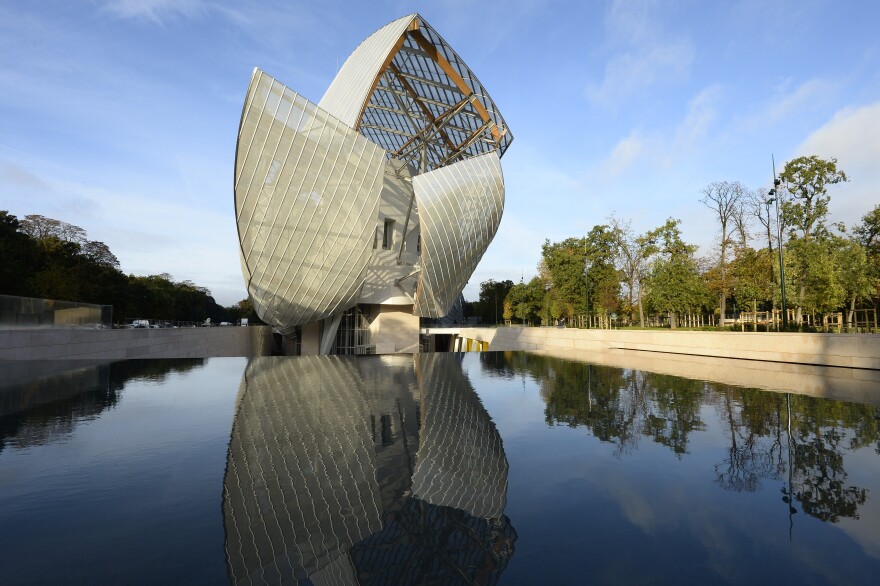With sculptural swoops and sweeps and unusual materials, Frank Gehry changed the course of architecture. His creations, such as the Guggenheim Museum in Bilbao, Spain, and the Walt Disney Concert Hall in Los Angeles, created a new architectural language.
At 86, Gehry is being honored with medals and museum exhibitions. He has unveiled a major river project for LA, and on Tuesday, Paul Goldberger, former architecture critic for The New York Times and The New Yorker, will publish Building Art: The Life and Work of Frank Gehry, a big new biography of Gehry.
Goldberger and Gehry have known each other for some 40 years. Gehry jokes that the biography gets "close" to capturing him — and that it even helped him learn a little about himself.
"I guess I do have an ego somewhere that comes out," he says. "I hadn't realized that I turn stuff down quite the way I do."
He has walked away from big jobs — wanting more collaboration, or more control. "I guess I'm ambitious," Gehry admits, adding that the work is artistically and emotionally fulfilling for him.
"I really want to make architecture. I love the relationship with the clients," he says. "I love going to Bilbao and people come out and hug me. We all need love. And it's nice to get it for doing things like that."
Gehry's audacious, glowing buildings capture movement, energy and light. He's taken hits from other architects and critics over the years who have said that the buildings don't work inside, or that they're too hard to construct — but stubbornly and passionately he has held onto one goal: to create buildings that inspire emotion.
"If you look at a great work of art in bronze from 600 B.C. and it makes you cry, some artist way back when was able to transmit emotion through time and space over years to today," he says.

He believes architecture can do that, too.
Art and beauty were in Gehry's DNA from the beginning. Born in Toronto, as a little boy he watched live carp swimming in his grandmother's bathtub on their way to becoming gefilte fish. He loved the shapes and movements they made. Later, fish became a motif in the buildings he designed. After he moved to Los Angeles at 18, his closest friends were artists, not architects.
"Their commitment to ordinary materials, to fresh ways to solve problems, making beauty out of the ordinary, affected him very, very profoundly," says biographer Paul Goldberger.
Take chain-link fencing — that basic barrier at construction sites and tennis courts. Gehry used it early on, in houses and commercial projects — and was ridiculed for it.
"I found the material that everybody hated," he says. It was a material "that was used ubiquitously by all cultures throughout the world, and that disconnection between those two ideas interested me, so I started looking at how I could make chain link — because I hated it, too — why not try to make it beautiful?"
Over the years, Gehry's materials got more sophisticated. The Louis Vuitton Foundation in Paris is constructed with billowing, soaring glass and wood. Before that, he made a sensuous Disney Concert Hall out of supple stainless steel. And glowing silver titanium swirls in the curves of the Guggenheim Museum in Bilbao, Spain.

"I was trying to express emotion," he explains. "The curves were from the fish — were a sense of movement with inert materials, which the Greeks did, the Indian cultures did it. We're living in a culture, in a time where movement is pervasive. Everything is moving. And so if we hook onto that and use it as part of our language, our architectural language, there's some resonance for it."

Movement, emotion, unusual materials, going against current thinking. These lifelong Gehry themes got transformed when digital technology came along. Goldberger says the digital age let Gehry catch up with his artist friends, through architecture.
"Frank was trying to conceive in his head shapes and forms and curves that were not particularly realizable by engineers," Goldberger explains.
Software from the aerospace industry let Gehry move his dreams into realities. He and his staff could engineer what sometimes started as squiggles on paper and convert them into structures that would stand up. They made thrilling buildings unlike any that had ever been seen before.

Fame and admiration engulfed Frank Gehry. But Goldberger publishes a revealing quote that shows Gehry can't take unmitigated joy at his accomplishment. "I wish I could live in the place people are making for me. I want to be popular, but I don't trust it," he said.
Gehry feels his work is never perfect, never finished.
"It can never be perfect," he says. "By definition it can't because we're defective creatures."
Building Art: The Life and Work of Frank Gehry is a penetrating portrait of a "defective creature" who helped to transform architecture in our time.
Copyright 2023 NPR. To see more, visit https://www.npr.org.




